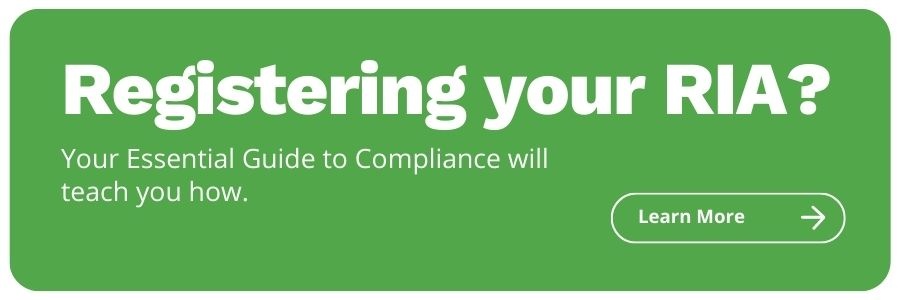Everything You Need to Know About Preparing for State Registration
Share this
Wouldn’t it be great if everything in life came with an instruction manual? I’m not talking about the hieroglyphics that IKEA includes with their furniture (eek!), but a real, honest-to-goodness guide to each step of the process in crystal clear, black-and-white print.
Preparing for state registration of your RIA is one example where a guidebook would be extremely welcome. Anyone who has spent ten minutes or more Googling, “How do I register an RIA in X state?” knows what I’m talking about; the information is confusing and often contradictory.
Part of the ambiguity comes from the governing body overseeing state registrations… or rather, the lack thereof. Each state is responsible for regulating the registration of RIAs operating in their borders.
You might be thinking, “Wait a minute, what about FINRA?” Actually, FINRA does not have regulatory authority over investment advisors. FINRA’s role is developing, operating, and maintaining the IARD system, which advisors use to “file” their registration documents so they are transmitted to the state regulators for review and approval.
Yes, you read that right—there really are 50+ sets of rules on how to register an RIA. In the immortal words of Douglas Adams: DON’T PANIC! Fortunately, that’s where I come in! I’m here to help you cut through the clutter to figure out what information is and is not relevant when getting your firm off on the right foot with your state. Let’s start at the very beginning (a very good place to start): Are you ready to begin registration?
Registration Qualifications
First of all, let’s talk about qualifications. For most states, in order to be eligible for registration, you will need to pass the Series 65 examination (or have taken both the Series 66 and Series 7 if you have been previously registered with a broker-dealer) or have one of the following designations in good standing: Certified Financial Planner® (CFP®), Chartered Financial Analyst (CFA), Chartered Investment Counselor (CIC), Chartered Financial Consultant (ChFC), or Personal Financial Specialist (PFS).
If you currently have not taken the required exam and do not have one of the listed designations, the Series 65 exam is often the best choice because it does not require you to be sponsored by a broker-dealer.
In addition to the designation or license, some states have additional requirements such as mandatory experience. A couple of examples are Minnesota and Connecticut. Minnesota specifically requires the firm to have at least one full-time supervisor responsible for compliance who has supervisory experience in a securities business for a minimum of three of the preceding five years.
One of the best ways to see if your state has any additional requirements is to check your state’s website. In addition to the links, the NASAA website has helpful state-specific pages with an overview of each states’ registration fees, minimum net worth, additional state required documents, and more. While this is helpful information to have, it is not always updated promptly when changes are made on the state level, so checking your state’s site is still the best resource. If the link on the NASAA page happens to be broken, you can also use good ol’ Google to search for “[Your State] Securities” to find your state’s site.
Another good option to learn more about your state’s individual regulations is to reach out to your state regulator. (I promise they don’t bite!)
Your state regulator is the guru of all things related to your state’s securities rules and regulations; having a comfortable working relationship with him or her from the start will only make your ongoing communications smoother and less anxiety-inducing. Most regulators welcome advisors who are willing to pick up the phone and ask questions.
Choosing a Firm Name
So here we are. We’ve arrived at a major juncture in your firm’s creation. What the heck will your firm’s name be? Take a deep breath. I know it feels like the name of your RIA will make or break your business, but I can assure you, it will not.
While undeniably important from a marketing perspective, the name you choose now is not permanent. The biggest concern in our timeline for getting your RIA up and running is picking a name that you feel comfortable using for the entire registration process. Changing the firm’s name midway through registration often creates delays and should be avoided whenever possible.
Once your firm’s registration has been approved, if you aren’t feeling the name you originally picked, you have the option of adding a DBA (Doing Business As) name, also known as the “Primary Business Name,” or changing the business entity’s legal name.
Here are a couple of things to consider when picking a name. Do you want a completely unique name or are you okay with having a name that is similar to another firm somewhere else in the country? BrokerCheck is a great way to search names you are considering to see if any other firms are using something similar. (It should be noted that the presence of a firm name on BrokerCheck does not restrict any other firm from using the same or a similar name.)
Another consideration: do you plan on referring to your firm by an acronym for expediency? Many firms opt to use an acronym of the firm’s name on the registration documents and client agreements to reduce the repetitions of the firm’s legal name being written in full throughout the documents. A name like ”Lori’s Optimal Life” may sound catchy, but do you really want your clients LOL-ing as they sign their contracts?
Establishing Your Business Entity
Next, let’s discuss your firm’s business entity. You want to get paid, right? One critical piece in making earning a reality is getting your business entity established. There are several business types from which to choose, including, but not limited to: Sole Proprietorship, General Partnership, Limited Liability Company (LLC), Limited Liability Partnership (LLP), and C Corporation. Many advisors choose to establish an LLC for the liability protections and flexible tax reporting options. Other advisors prefer a Sole Proprietorship for the ease of formation.
The key to remember here is that there isn’t one business type that works for every firm. Again, the laws and benefits can vary state-to-state and each advisor’s comfort with liability and tax needs are unique. You will likely want to consult with your accountant and/or a lawyer specializing in business formation before deciding which type is best suited to your firm.
It is worth noting that in some states, business entity filings are public and searchable on the state’s Secretary of State website. This does present a possibility to advisors who are currently employed that your employer may become aware that you have an undisclosed outside business activity.
Also, it’s good to keep in mind that many states will also need to see a copy of your firm’s articles of incorporation or other documents that indicate the form of organization, as well as the firm's By-Laws or Operating Agreement. (This is another good project for your lawyer if you aren’t comfortable drafting these documents yourself.)
And don’t forget to apply for your EIN (Employer Identification Number)! Firms that are organized as any type other than a Sole Proprietorship need an EIN to complete the ADV Part 1 filing.
Setting up a Bank Account
Once your business entity has been established, you will want to set up a bank account for the firm. Most states have a net worth requirement for RIAs, and proof that your firm meets that minimum (usually through the submission of a balance sheet) is often one of the essentials for registration. The minimum net worth is state-specific and can range from the firm being solvent to tens of thousands of dollars. This is another great opportunity to check the NASAA website or your state’s website for more info.
Something to think about: if your firm will have discretionary authority over, or custody of, client assets and accounts, the net worth requirement for your state will likely be higher. For example, at the time this blog was published, RIAs in Washington state without discretion or custody are only required to maintain a positive net worth, but RIAs with discretionary authority must maintain a net worth of $10,000 at all times. RIAs with custody are held to an even higher standard of maintaining a net worth of $35,000. Firms that are not organized as Sole Proprietorships cannot claim personal assets to meet the minimum net worth for the firm. Some states will allow advisors to obtain a surety bond to meet all or part of the minimum net worth requirement, but again, this can vary by state.
While you are reviewing the minimum net worth requirements for your state, you should also check and see what guidelines your state has established for E&O (Errors and Omissions) insurance. A few states, such as Oregon and Vermont, require proof of insurance to be provided as part of the registration process. In Vermont’s case, the E&O insurance must also include a cybersecurity clause that includes evidence of adequate insurance for the risk of a cybersecurity breach.
Contact Information
If you’re still with me after all of that, pat yourself on the back. You’re almost ready to initiate the first of the FINRA documents for registration, the SAA (Super Account Administrator) Form, but before we jump into that process, there are a few more details to discuss.
In order to complete the SAA form, you will need three more things: an email address for the firm, a phone number for the firm, and a physical address as your primary place of business for the firm.
I often see advisors rushing to get their SAA Form submitted, then purchasing their website domain (and creating their email address) a week later. This isn’t the end of the world, but it can cause some hiccups with the way the SAA Form is processed.
Ideally, you will have an email address established prior to submitting your SAA Form so the “authorized” email address for the firm’s CCO matches on all registration documents.
If you aren’t able to have the firm’s email address finalized prior to completing the SAA Form, the next best option is to pick an email address (personal or temporary) that you can use throughout the registration process, then change after the firm is approved.
The email address used on the SAA Form will need to match the CCO’s email address as disclosed on the Form ADV Part 1 to avoid discrepancies. To change the email address, an Authorized Signatory from your firm must contact the FINRA Firm Gateway Call Center to request an Update/Replace SAA Form, then you will be able to update the email address on the Form ADV and other documents.
On the topic of websites, if you are working on creating a website for your firm during the registration process, that’s great! Way to be ahead of the curve. Getting your website fine-tuned for public consumption is an excellent use of your downtime while you are waiting for the regulators to complete their review.
However, I would strongly encourage you to keep any and all websites, blogs, and social media for the firm private or unpublished until your registration has been approved. Some state regulators will search to see if the firm has any active and undisclosed websites during the registration process, and active websites advertising your firm can create the appearance that you are soliciting clients without being registered. Not good. It’s best to keep your web-presence offline until you’ve got the green light!
Picking your firm’s phone number is a bit simpler. Many advisors choose to use their personal cell phone number until they have a dedicated business line. There’s nothing wrong with this approach as long as you don’t mind getting calls and texts from clients whenever they feel like reaching out.
For the more privacy-minded, there are options such as using a VoIP number (e.g. Google Voice) or an answering service/virtual receptionist. Just make sure that whichever option you choose gives you the ability to archive client communication text messages (if you use that form of communication).
Let’s discuss your principal place of business address. What does that even mean? For the purpose of your firm’s registration, you will need a physical address that can be publicly disclosed on your registration documents. Many advisors use their home address for the initial registration, and you can too if you are comfortable with your address being listed.
Home addresses can be marked as “private residence” on the ADV Part 1 to remove the address from public view for some of the fields, but the address included on the ADV Part 2 cover page will be publicly available to view. Coworking spaces and some “virtual” offices (with actual meeting space) are acceptable in some circumstances, but PO Boxes, virtual mailboxes (one that opens and scans mail), or UPS boxes with an “address” are generally not acceptable from a regulatory perspective.
When you are thinking about your principal place of business, ask yourself, “Where would I meet with an auditor? Where can he/she review my books and records?” Sometimes you will need to disclose multiple locations. If you perform advisory activities (such as client meetings) at a specific location, that location will need to be disclosed.
Where will your books and records be stored? All storage locations for books and records must be disclosed. (If your books and records are all stored electronically, an additional storage location is generally not required.) You can also list a separate mailing address in addition to the firm’s physical address. A PO Box is acceptable as the mailing address.
Bonus tip: If you are using a private residence as your principal address, you can use “by appointment only” as your business hours on the Form ADV Part 1, unless you are planning to be consistently present at your primary business address at the same time every day.
Submitting Your FINRA SAA Form
You are now ready to submit your FINRA SAA Form! The FINRA SAA Form will provide you access to the FINRA Firm Gateway, the portal for submitting your electronic registration documents (the Form ADV Part 1, Part 2A, Part 2B, and the Form U4) to the state. The submission of the SAA Form will also assign a CRD number for your firm. The Form can be completed and submitted electronically using DocuSign. New RIAs will use this form: SAA Entitlement Form.
Advisors who are currently working with a broker-dealer, RIA, or insurance company are often concerned about whether or not completing the SAA Form will somehow notify their current employer that they are starting their own firm. This is generally not the case.
With that being said, let’s talk about employer notification during the registration process.
In most cases, if you are currently working with a broker-dealer, RIA, or insurance company, your current employer will not be subject to notification until you file your Form U4 to register as an IAR (Investment Advisor Representative) of your new firm.
However, if you have already listed your business with your Secretary of State, then your current employer may become aware of your activity. Some firms, as a part of their review of outside business activities, will search all of their representatives on the Secretary of State’s website to see if they are listed as officers, directors, etc. of any other business. This would usually occur during a branch audit, or an audit being conducted by regulators.
And there’s the rub. In a perfect world, you would be able to give your employer two weeks notice and two weeks later have your new firm up-and-running. In reality, the logistics of registration make this difficult or impossible to execute.
The majority of states will require at least one IAR registered (or seeking registration) with the firm for registration to be approved. So, while you can file the Form ADV with the state prior to terminating your current employment, your registration will, in many cases, not be approved until you have terminated your current employment and filed the Form U4.
In general, it is best to prepare for at least a minimum of a month of transition time from leaving an employer to having your new firm’s registration approved.
Your Firm's Services
We made it to the fun part! This is the part of the process you’ve probably spent the most time thinking and dreaming about as you’ve been preparing to set off down the road of RIA registration. It’s time to discuss your firm!
Let’s start with your firm’s services. What services are you planning to offer your clients? (Besides real financial planning, of course.)
How about investment management? Tax preparation? Educational seminars or workshops? Will you offer speaking engagements? Pension planning? Something completely new and different?
Some advisors focus on one area of service and specialize in that area exclusively. Others offer a range of services to create a one-stop-shop for their clients. Picking a niche and identifying your ideal client can go a long way towards helping you visualize your dream firm.
Ultimately, the choice is yours. If you get to the point where the decision-making process has become paralyzing or frustrating rather than exciting and invigorating, you may want to consider finding a good coach to help you navigate the sticky spots of the decision-making process with confidence and support.
Another consideration is the benefit of observing the infamous “KISS” principle of keeping things simple. Trust me, simplicity is your friend. If you include only the services you are comfortable describing in detail (including the applicable fees) using clear, concise language on the initial registration, the registration process will be quicker and smoother overall.
If you do not feel confident answering questions from a regulator about a service, it would be advisable to wait and add that service to the ADV later after you’ve had the opportunity to work out the logistics in full. Additional services can be added at any time after the registration has been approved.
Some sample questions to get you started:
For your financial planning services:
- Will you only offer ongoing comprehensive financial planning, or will you also offer limited scope financial planning for an hourly or fixed fee?
For investment management:
- Will you be executing your own trades, or will you utilize an outside manager or TAMP (Turnkey Asset Management Platform)?
- Who will your custodian be? How much do you know about your custodian’s trading practices, technology, platform, and reporting capabilities?
- Will you utilize a Wrap Fee Program?
- Will you have discretionary authority?
What about fees? Admit it, most of us like to get paid for our work. But how much? And how often?
A few things to consider:
- For your investment management fees, is your fee schedule “tiered” or “blended” (combined weighted fee)?
- Will you directly deduct fees from client accounts or accept payment by EFT (Electronic Funds Transfer like AdvicePay) or check?
- Financial planning—easy, right? Aren’t you using the monthly retainer model?
- Will you bill in arrears or advance? Monthly or quarterly?
- Will you offer any services at an hourly fee?
- How much notice do you require for a client to terminate your services, and what is your refund policy?
- How will you charge for your services? Will you charge for each service separately as “a la carte” offerings where clients can pick and choose the services that they wish to participate in, or will you offer discounts for clients who enroll in multiple services?
I know that’s a lot to think about, and it may seem overwhelming when you consider that we haven’t even touched on the actual registration documents yet, but I can promise you one thing: the more time that you spend preparing for your initial registration, the easier and faster the process will be. Once you are confident describing your firm’s services, fees, and policies, you will have the answers you need to draft and file your registration and begin the next step in the journey to running your own RIA.
Excellent job! Let’s recap your progress. So far, you’ve:
- Verified IAR qualification requirements (including any experience requirements) for your state.
- Named your firm.
- Established your business entity.
- Established your business bank account and funded the account to meet the minimum net worth requirement for your state (or obtained a surety bond, where applicable).
- Created or decided on an email address for your firm.
- Obtained or decided on a phone number for your firm.
- Selected a physical address for your firm.
- Submitted your FINRA SAA Form requesting access to the FINRA Firm Gateway and assigning a CRD number to your firm.
- Prepared for transitioning from your current employer (if applicable).
- Decided which services your firm will offer.
- Determined how to price your firm’s services and developed policies around your fees to include refunds, payment types, etc.
Congratulations! You’re ready to start your state registration! For those of you are members of XYPN, now is the perfect time to sign-up for our Initial Registration Services. Our Compliance Team is here to help you through the next steps of drafting and filing your registration documents.
 About the Author
About the Author
As a Compliance Specialist for XY Planning Network, Ashley Hunter walks advisors through the registration process. Her keen attention to detail helps advisors understand the many rules and regulations of the process, and lets them cut through the clutter to determine what information is and is not relevant along the way. She is a self-professed “geek” with a love of all things related to regulations and documentation.
Outside of work, Ashley is frequently spotted petting strangers’ dogs, paddleboarding, backcountry skiing, reading science fiction novels, and photographing pretty much everything around beautiful Bozeman, Montana.
Share this
- Advisor Blog (721)
- Financial Advisors (244)
- Growing an RIA (128)
- Business Development (95)
- Digital Marketing (95)
- Marketing (92)
- Community (82)
- Start an RIA (76)
- Coaching (74)
- Running an RIA (72)
- Compliance (70)
- Client Acquisition (68)
- Technology (67)
- Entrepreneurship (64)
- XYPN LIVE (64)
- Fee-only advisor (49)
- Sales (49)
- Bookkeeping (46)
- Client Engagement (45)
- Practice Management (44)
- XYPN Books (43)
- Scaling an RIA (42)
- Investment Management (41)
- Client Services (31)
- Employee Engagement (31)
- Financial Education & Resources (31)
- Lifestyle, Family, & Personal Finance (31)
- Market Trends (26)
- Journey Makers (24)
- Process (18)
- Niche (13)
- SEO (9)
- Career Change (8)
- Partnership (8)
- Transitioning Your Business (7)
- Sapphire (6)
- Persona (4)
- Transitioning To Fee-Only (4)
- Emerald (3)
- Social Media (3)
- Transitioning Clients (3)
- RIA (2)
- Onboarding (1)
Subscribe by email
You May Also Like
These Related Stories

Avoiding Common Regulatory Filing Deficiencies for Your RIA
Sep 23, 2019
18 min read
.jpg?width=360&height=188&name=State-De-Minimis-Exemptions-from-RIA-Registration-(or-Notice-Filing).jpg)
State De Minimis Exemptions from RIA Registration (or Notice Filing)
April 25, 2022
7 min read






